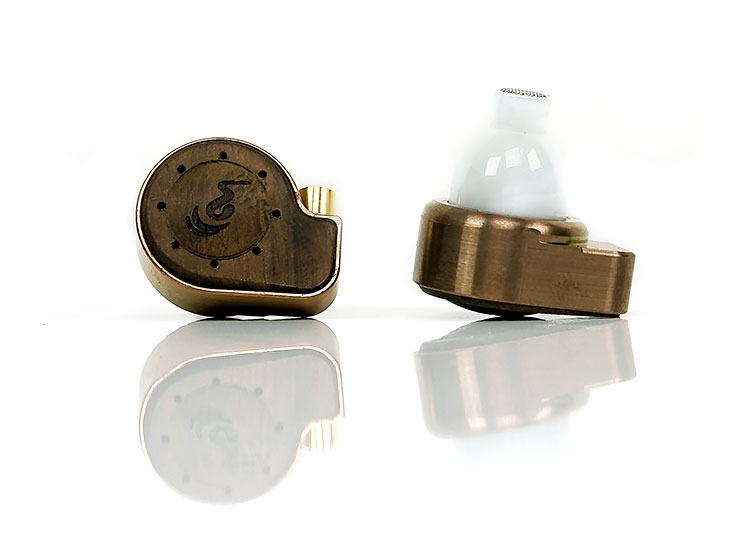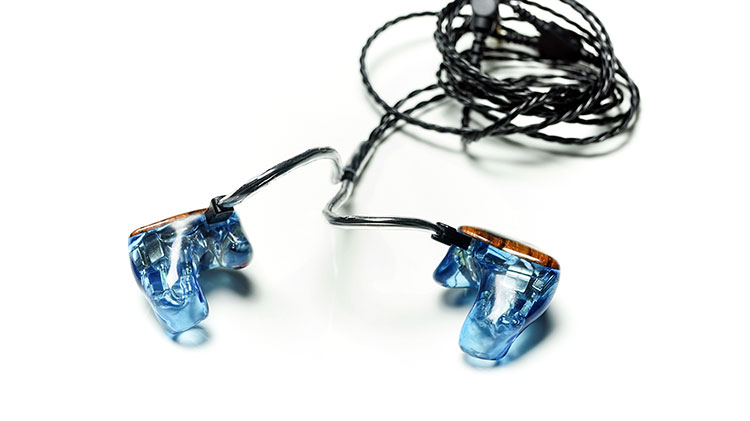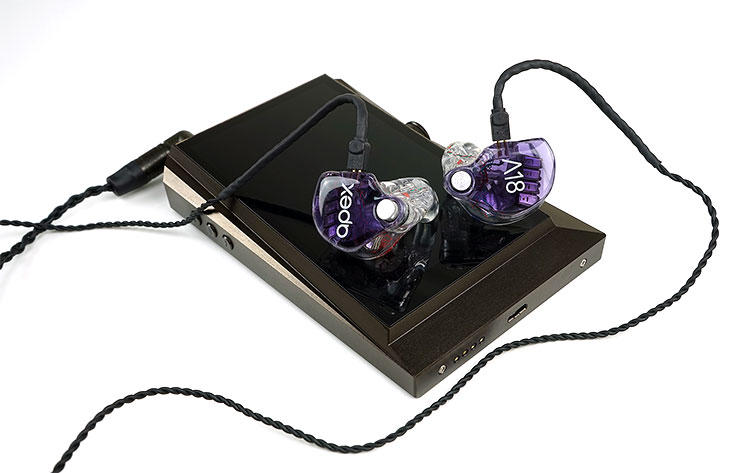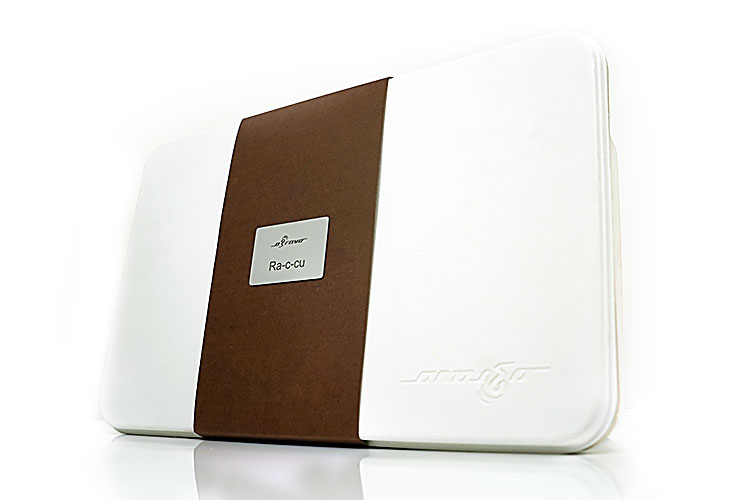Select Comparisons
oBravo EAMT-2c
$2999
Technical
Our previous award winner from 2016 and still a top performer to this day. The EAMT-2C may have been overtaken now by more expansive and complex competitors such as the A18 or Mason V3 but it still delivers a very unique and open sound.
The form factor is slightly different with that tear-dropped shape but it still used the same ceramic chamber and the intention is much the same as the Ra C-Cu, with lush tonality and a wide-open soundstage.
Internally, the EAMT-2C uses a smaller 12mm NDD driver as well as the previous version of the AMT driver for tweeter duties. The rating is also more efficient at 16Ω and 105dB compared to the Ra’s 182Ω and 104dB specs.
You may not have to adjust the volume too much between the two of them on a good amp but the Ra C-Cu is more demanding for quality power than the EAMT-2C. The sensitivity to higher noise floors on both is impeccable.
Performance
Both IEMs scale with better amping power and a higher quality signal. The Ra C-Cu’s larger NDD driver will provide a much purer low-end and much better sub-bass presence and texture.
If there was one thing I remarked on in my old EAMT-2C review was just a slight yearning for more sub-bass texture and power. The Ra C-Cu delivers that in much greater quantity without sounding overly physical at the same time.
On the opposite end of the spectrum, the AMT 8II tweeter seems much cleaner and more extended than the 2C’s older AMT MK1. There is more energy in that final octave up to 15k with the Ra C-Cu.
However, the Ra C-Cu is pickier with the synergy than the EAMT-2C. You will get superior headroom and an airier treble performance but you do have to watch both the quality of power and the amount of power you feed the Ra.
Too much, or too cold sounding and it can come across as sharper than the 2C. Too little and it tends to come across as more veiled, especially in the upper mids.
On initial impressions, most will say the EAMT-2C is the more forgiving of the two, and true enough its top end is much easier to drive. However, even on relatively modest amps that match well with the Ra, the tonal quality is much more refined, particularly with vocals that sound sublime.
On the EAMT-2C, you get a little more immediacy and a more upfront vocal but not as silky smooth and as detailed sounding as the Ra.
Rhines Stage 7
Starting at €1599 ($1950)
Technical
Stage 7 is Rhine’s TOTL 7-balanced armature custom monitor with a 4-way crossover. This one has been with me for a while but yet to publish a review on it. Stage 7 is rated at 21Ω and 118dB and is miles more efficient and much easier to drive than the Ra.
It will have some scaling properties in terms of the quality of the audio signal but desktop amps are unnecessary to sound optimal.
The Ra, however, will play better on higher noise floors and also jump over high impedance output hurdles without distorting its presentation. DAPs like the HiBY R6 and amps like the Tempotec Serenade iDSD will skew the Stage 7 low-z frequency response.
Much like the A18 is beautifully custom-designed. Whilst the materials are not as decadent as ceramic and copper the fit is going to be that bit more precise and the seal is going to be much better.
Then again, the Ra C-Cu is a semi-open design so it is not going to be competing for the utmost levels of attenuation against something like the Stage or even the A18.
Performance
Tonally the Stage 7 is dark sounding with a warmer but woolier mid-bass and thicker sounding and prominent lower mid-range. Instrumental timbre is decidedly euphonic and richer sounding than Ra’s linear and cleaner signature but at the same time, it is also far woolier and less detailed sounding.
You will also notice how attenuated sounding the top end is on Stage 7 in comparison to the Ra. There is simply next to no headroom and extension in the Stage 7 treble response which pushes down into the mids to such a level that it sounds veiled in comparison. The Ra C-Cu has bags more upper treble energy and headroom with a far more open and spacious midrange.
All this helps cast a far more convincing and holographic soundstage on the Ra C-Cu. The NDD driver digs deeper, delivers much better levels of detail, and sounds snappier to my ears.
The Stage 7 has a decent sub-bass presence but it is more forward and intimate sounding and nowhere near as good in delivering nuanced low-level spatial cues.
This is really a chalk and cheese comparison with the Stage 7 and the Ra. Stage 7 is so even harmonics dominant for a TOTL CIEM you could throw anything at it and it would sound quite smooth and musical.
What the Ra C-Cu offers is far more resolving and accurate sounding with bags more clarity and articulation. Things you notice on the Ra C-Cu will simply slip by you on Stage 7.
64 Audio A18
$2999
Technical
The 64 Audio A18 is their top-of-the-line custom-made multi-driver IEM. This is an 18-driver masterpiece with a BA hybrid Tia technology design. Last year we reviewed this and gave it a whopping 9.6 for its tonality we were impressed by its level of detail, control, and a big soundstage.
The APEX technology also played a valuable role in reducing potentially damaging consequences for your ears as well as offering a level of tonal tweaking with the M20 and M15 modules. We thought the M20 module was the more musical and interesting of the two and served to fatten up what is otherwise a largely neutral sound.
On a more superficial note, the packaging and accessory lineup for the Ra C-Cu just slays the A18’s neat but rather spartan presentation, but then it should right?
Performance
The A18 is rated at just 9Ω and 116db and is way more sensitive than the Ra C-Cu requiring much less power to be driven optimally.
It will be more sensitive to higher noise floors and show up background hiss were gain is aggressive so for portable amping on a technical level it is a little pickier than the Ra. Synergy-wise it is less fussy than the Ra C-Cu and will sound pretty good from most efficient amps.
Watch for output impedance on the A18. At just 9Ω it will have a low-z skew on the likes of the HiBy Music 6 and its tone will change as a result.
The Ra, on the other hand, has no such issues at 182Ω. However, to get the Ra C-Cu to sound optimal you need a fine balance of good power combined with a source or amp that has a higher level of 2nd order harmonic distortion to keep the AMT 8II on an even keel.
Tonality
Tonally, the A18 has a natural to neutral quality to its timbre with a quick-paced tempo, excellent clarity, and very good control indeed, particularly with the Tia high driver. Using the M20 will also deliver a bit more low-end body and a fuller-sounding vocal-sounding presence than the more linear-sounding M15 module.
As spacious and detailed as it is you can tell it is a BA design once you A/B with the Ra. As I mentioned in my discussion on the bass performance and imaging of the Ra C-Cu there are subtleties that it can convey that get missed with the A18.
The low-end on the Ra C-Cu is more natural sounding, hits harder, and coveys more detail. The Ra C-Cu’s bass texture and layering make the A18 sound just a touch one dimensional as a consequence. Little nuanced low-end spatial cues heard on the Ra do not catch your ear as much when you switch to the A18.
Imaging
The imaging on the Ra C-Cu also has a more 3D-like or immersive presentation. The A18 may feel wide and yes, the control is excellent but it is not quite as open-sounding.
That echo demo I used in the imaging description goes a long way to demonstrating how much better the Ra C-Cu is with “painting” an accurate picture of depth. You get a better sense of just how exactly big that room is in the song with the Ra.
Tia vs AMT 8II
Both the Ra C-Cu and A18’s treble performance is well extended into the final octave however they differ markedly in just exactly how far and how much energy there is until the final moment. With the A18 the 10k marker is decidedly lower than its peak around 12k. It then drops away fairly quickly around 14k.
The Ra C-Cu is more sustained from 10k right up to 15k so the level of sparkle and energy is much higher than the A18. As a result, the A18 actually might sound a little more relaxed and more forgiving than the Ra. However, it does not deliver quite the same level of air or headroom which some people will definitely prefer.
Our Verdict
Before I started writing this review I checked in with Audio Sanctuary in London which sells the Ra C-Cu and we spoke about the customers who bought it thus far. I had the impression that they would be rather affluent but it was simply not the case.
Yes, they could afford it but they tended to be more middle-class status with a fairly regular wage and normal budget levels in life. Perhaps my own relative poverty-stricken bias was clouding my expectations and I would caution you on your own when reading this.
Whilst I have no doubt serious system buyers are among the customer profiles it is also true to say that other people who are buying the Ra C-Cu are just like you and me. I did ask what was their compelling reason for buying it and I was simply told they said it was the best sound they ever heard. Fair enough!
Is it the best sound I have ever heard from an IEM? When the synergy is right yes it is, when the matching is all wrong perhaps not. And that is the crux of the Ra C-Cu story. Think carefully about what it is you are pairing it with because it is not simply about power although power is part of the formula.
It is also not just about the quality of the source or genre though it helps. It is a balance between power and tone and what it is you want to listen to that makes the Ra C-Cu so unique and compelling.
Personal Preferences
My personal preferences with the oBravo Ra C-Cu veered to quality tube amps with silicone custom tips and genres with a firm focus on nuanced detail. Music that stretched the stage and demanded pinpoint imaging in every possible dimension. There I felt it had an almost speaker-like quality.
However, this preference may not be yours. If you are into something less fussy, more laid back, and easier to drive from DAPs there are plenty of excellent options that cost less than the Ra. I won’t sugarcoat that part of the decision-making process because most people do see an IEM as a pick-and-go kind of headgear. This is not that sort of IEM.
Also, I honestly do recommend you demo widely to find that perfect match before you buy the Ra C-Cu. I include cables, tips, and DACs into that equation. If you are prepared to do your research, and I suspect at 10k you will most likely will, then the Ra C-Cu has the potential to be one of the most rewarding IEMs out there.
oBravo Ra C-Cu Technical Specifications
- Frequency Response: 10Hz~45KHz
- Tweeter: 8mm Air Motion Transformer II Tweeter
- Dynamic Driver: 16mm Neodymium Driver
- Impedance: 182 ohm
- Sensibility in dB: 105dB







